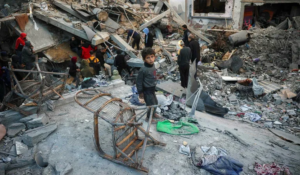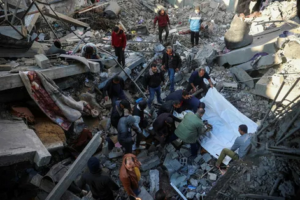Researchers say study shows Gaza death toll far exceeds official figures

Palestinians in central Gaza after an Israeli strike, 8 January 2025
Nir Hasson reports in Haaretz on 11 January 2025:
The number of “traumatic injury deaths” in the Gaza Strip since the war there began is significantly higher than what is reported by the enclave’s Hamas-controlled Health Ministry, according to a new study in Lancet published on Friday.
The latest ministry estimate is that 45,541 people have been killed in the war and that around 10,000 missing people are buried under rubble. According to researchers from the London School of Hygiene and Tropical Medicine, this figure is actually just a minimum.
The Gaza Health Ministry published a list of 40,717 names in October. In the absence of an alternative tally or evidence to disprove the ministry’s figures, international organizations, foreign governments and the foreign media rely on them entirely. Nonetheless, Israeli sources regularly reject the ministry’s estimates, arguing that they are misleading.
The current war is the first round of fighting in which Israel has not officially counted the number of Palestinians killed. The only figure that the military has published since the start of the war is that 14,000-17,000 terrorists have been killed.
According to the military website, 14,000 terrorists have very likely been killed, with the probability of another 3,000 dead being low to medium. No new figure has been provided since August, even though the fighting has intensified in recent months and dozens of people have been killed in Gaza almost daily. The military does not provide any count of the number of Palestinian civilians killed in the fighting.
The current study is based on an analysis of three lists of the dead: Gaza Health Ministry hospital lists, an online survey by the Gaza Health Ministry and obituaries published on social media. The researchers statistically analyzed the overlap between the three lists.
“If I give you three lists and you see that they overlap a lot, you will tend to conclude that there are unlikely to be that many people, if any, that have not been captured by the lists,” Prof. Francesco Checchi, an epidemiologist and health expert, and one of the study’s authors, says. “Whereas if you see very little overlap, you will tend to infer that there are maybe many others out there that have not been counted.”
The study examined the first eight months of the war and concluded that the number of deaths was 64,260 – 41 percent higher than the estimate published by the Gaza Health Ministry at the end of June. The researchers only included traumatic injury deaths and did not consider mortality from hunger, disease and cold. The study also does not discuss the latest list of fatalities, but the researchers estimate that the number of dead in Gaza is now around 70,000.
The study says, “Our analysis supports the accuracy of the Ministry of Health reported mortality figures but suggests that these are to be treated as a minimum estimate subject to considerable under-reporting.”

Palestinians searching the site of an Israeli strike in central Gaza on 8 January 2025
Asked where all these dead are, Checchi says that it’s reasonable to assume that the number of bodies buried in the rubble or in areas that cannot be reached is significantly higher than the ministry’s estimate. It is also possible that there are many more families that have been wiped out, leaving no one to report their deaths, he says.
“It is not at all unusual that there is under-reporting of mortality in these kinds of fairly chaotic military operations,” Checchi says. “But if we… just look at how well reporting systems tend to work in crisis settings, then we always see that they deteriorate and then they therefore fail to actually count everyone.”
Checchi says that the level of mortality in Gaza is rare compared with other conflicts in the world – both the overall rate, about 3 percent of the population, and the large number of women and children directly killed by traumatic injury. The study said that young men in Gaza are at higher risk of mortality relative to their proportion of the population, but that 59 percent of the dead are women, children under the age of 18 and people over the age of 65.
Checchi adds that he was in Darfur in 2004, “and there we saw extremely high levels of mortality as well, but very, very focused in adult men primarily. with child mortality largely due to disease.”
Haaretz contacted experts unaffiliated with the study to give their opinion on its findings. They said that the researchers’ method of measurement was widely accepted in the field of military conflicts. Prof. Michael Spagat, an internationally renowned researcher of mortality in armed conflicts at the University of London, says that the statistical method used by the researchers has previously been used in other conflicts.
“This is a method that has been applied before in conflict settings with some success in some settings, e.g., Kosovo and a notable failure in Peru,” he says. “This is a serious effort. It can’t easily be dismissed… It’s really complicated so, inevitably, close scrutiny will reveal flaws. But I think that the main estimates are credible.”
Historian Lee Mordechai from the Hebrew University of Jerusalem, who writes about and closely tracks reports from Gaza, says he believes the study is the “most methodologically sound estimate of Palestinian mortality estimates published to date, and this estimate is going to remain in the debate even if there are others.”
However, he pointed to a possible flaw: the lists based on social media posts might miss the cause of death and include deaths that were not caused by trauma. “There is a lot of missing information and they use statistics to fill it, but I understand that this is standard or even above the standard,” he said.
Prof. Nadav Davidovitch, an epidemiologist at Ben-Gurion University in the Negev and head of health policy at the Taub Center for Social Policy Studies in Israel, says of the study, “Scientifically, it’s legitimate, but there may be biases here. The cause of death isn’t always defined, and the question may be raised whether all the dead [were killed] by Israel or if people killed by Hamas are included here.”
He adds, “But all in all, the article shows that mortality and disease morbidity in Gaza are dramatic and the health system there is in a catastrophic state. We don’t want to compete for whether it is better or worse than Sudan, and we’ll probably never know the real numbers.
Davidovitch further says that [f]or Israel’s sake, especially if it wants to see itself as a modern country, it cannot stand by, and it must work with the international community to rebuild Gaza’s health care system. It’s impossible to sever this from the political decisions about ‘the day after.’ We must end the war and bring the hostages home.”
This article is reproduced in its entirety
